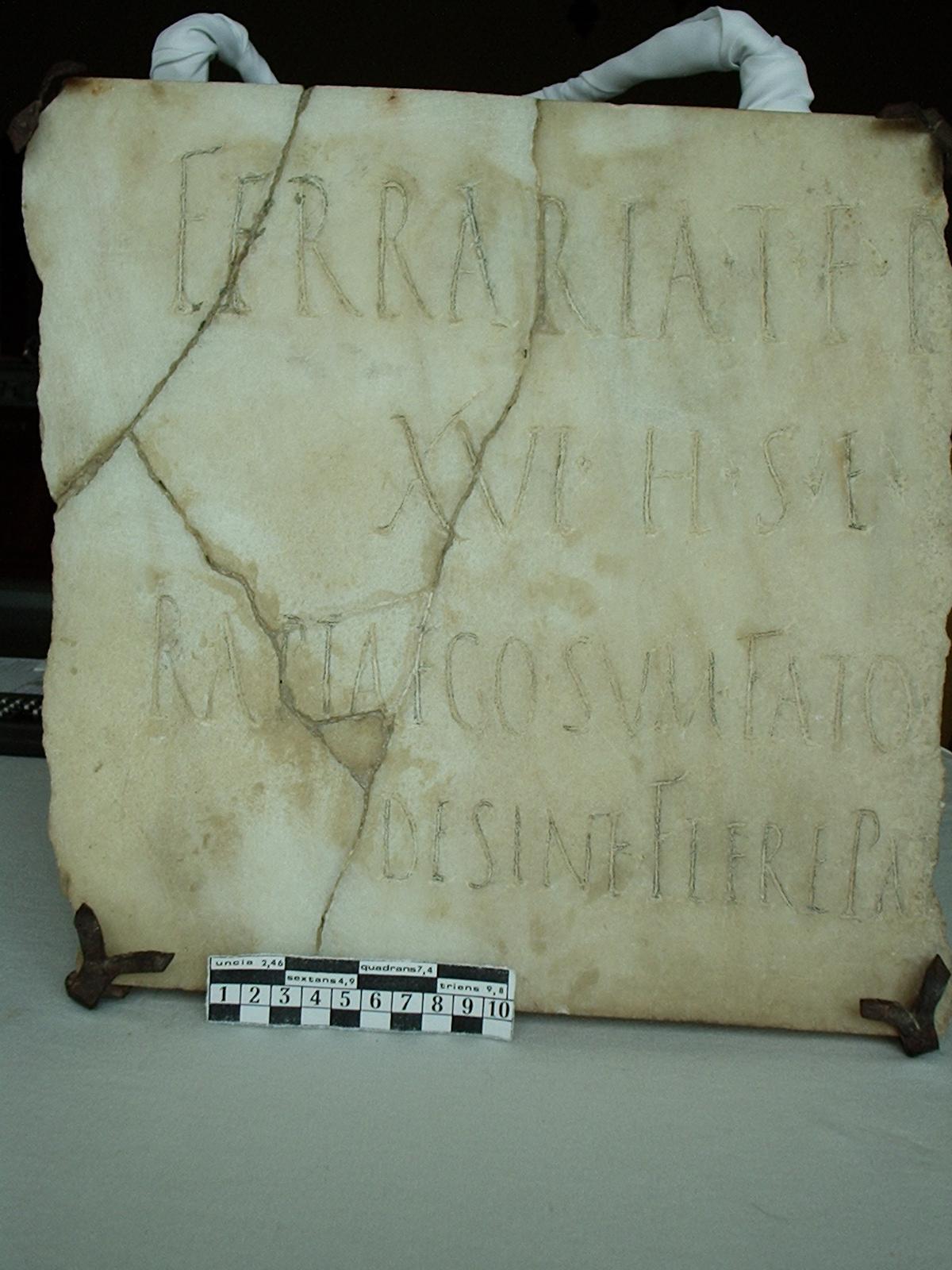Epitaph of Ferraria
Reference CIL II2/5,1057 | Description | Lyrics | Location | Chronology | Epigraphic edition | Translation | Apparatus | Comentary | Type of verse | Text divided into verses and metric signs | Images | Bibliography | Link to DB | Author |
Epitaph of Ferraria
Description
- Idno filename 22/01/0089
- Type of inscription: Sepulcralis
- Material Description: Rectangular tablet of white marble.
- Conservation status: Broken on the right-hand side, affecting the text. Five fragments joined.
- Dimensions height/width/depth (cm): 30.4/31.5/1.5
-
Epigraphic field:
- Layout: Even lines indented in praescriptum and carmen. Verse boundary respected. Shallow-cut book script. Words separated by interpunction signs: hederae in the praescriptum, with stalk pointing left, except between <XVI> and <S>; in the carmen, triangular interpunctions with the vertex pointing downwards.
- Epigraphic field execution: Upper and lower edges, front and back face polished.
- Corpus: II2/5,1057
- Preserved
Lyrics
- Font:Libraria
- Letter size:4-3 cm
- Description of the letters:Triangular interpunctions with the vertex pointing downwards.
Location
- Place of discovery: It was found in Osuna.
- Geolocation
- Conservation location: Kept in Algeciras, in the private collection of F. Fajardo, who inherited from his now deceased father.
- Location with Modern Nomenclature España / Cádiz / Algeciras
- Location with Old Nomenclature Hispania / Baetica / Astigitanus
Chronology
- Inscription's dating: Between year 100 and year 199
- Dating explanation: 2nd c., time of the Antonine dynasty due to the paleography.
Type of verse
- Type of verse: Dactílico (hexámetro)
- Verse/line correspondence: Si
- Prose/verse distinction: Si
Epigraphic edition
Ferraria ▴ T ▴ f ▴ Iu[‑ ‑ ‑ an(norum)]
XVI ▴ h(ic) ▴ s(ita)▴ e(st) ▴ s(it) [t(ibi) ▴ t(erra) ▴ l(evis)▴]
rapta ▴ ego ▴ sum ▴ fato ▴ +[‑ ‑ ‑]
desine ▴ flere ▴ par[ens ‑ ‑ ‑]
Text divided into verses and metric signs
Rapta ego sum fato [‑ ‑ ‑] lww|l/l|x/[n|ln|lkk|l~]
desine flere par[ens‑ ‑ ‑] lww|lww|[l…]
Translation
Ferraria, daughter of Titus, 16 [years of age], is buried here. May the earth rest lightly on you. I was snatched by a fate... Dry your tears, mother...
Bibliography
RECIO 1976, 95 cum im. phot.; RODRÍGUEZ NEILA 1976, 377–383 (inde AE 1976, 284 b); GONZÁLEZ FERNÁNDEZ, CILA II 647 cum im. phot.; THIGPEN 1995, 325, quae in linguam Anglicam vertit; GONZÁLEZ FERNÁNDEZ, II2/5, 1057; FERNÁNDEZ MARTÍNEZ – CARANDE, CLEB SE17, cum im. phot, quae in linguam Hispanicam verterunt; CUGUSI 2012, 43. – Cf. HERNÁNDEZ PÉREZ 2001a, 84 ss.
Apparatus
1 Ferraria.t.f.lu Recio, qui suppl. Lu[cilla? ann.], T(iti) f(ilia) D Rodríguez Neila, González Fernández, Thigpen; Iu [ ann(orum)] suppl. González Fernández. – 2 XVI . h . s . e… Recio, suppl. González Fernández. – 3 fato i[niquo – – -] Rodríguez Neila. – 4 pa[ter – – -] Rodríguez Neila, par[ens – – – – – -] suppl. González Fernández.
Comentary
Dedicated to Ferraria, sixteen years of age, by her father or mother, more likely by her mother (parens for mater, metri causa), with the topoi for mors immatura. : l. 3 rapta (cf. CLE 555,2: rapta de luce serena; 1620,3: genitoribus subito miseris rapta es; 1823,10: acerva a matre rapta es; etc.), et ex exemplis de litteris desumptis: Mart. 1.116.3: hoc tegitur cito rapta suis Antulla sepulcro; Ov. met. 13.450: rapta sinu matris). In that same verse the reason of the fate, so blind and inexorable that it takes those who are not supposed to die yet, is also mentioned within the topoi of mors immatura (cf. for example, CLE 1011,1: invida mors rapuit fato crudelis iniquo; 1213,1: fato crudely siqua est erepta puella; etc. By last, in the preserved fragment of the second verse we find the exhortation, also topical, of the deceased to the living so they reduce their crying (cf. Lier 1903, p. 571; 600-602; y 1904, pp.55 ff.); the expression has many literary parallels, for example, in Cat. 61.86, and it reappears in numerous epigraphic testimonies (cf. for example 775,7: te flent orbati parentes; 820,1: quem flentes doleunt miserique parentes; 1405,13: tristes flentesque parentes and CLE 1211.11; 507.2; 1068.3) the same motif is also evoked in SE1, 5-6.
In the verse part, the first hemistich of a hexameter, up to the penthemimer, is conserved along with the first two feet of what could be another hexameter or more probably a pentameter. Ferraria is an infrequently attested nomen in the anthroponymy of Hispania; there is another example, also from Osuna (II2/5,1056).
Author
- Author:C. Fernández Martínez, R. Carande Herrero
- Last Update2024-02-25 19:39:34
- Autopsy date:2003
You can download this






